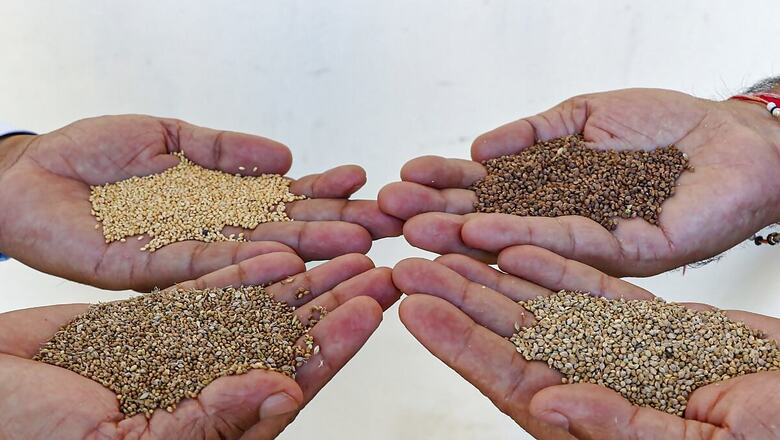
views
Many years ago, while returning from a remote rural area somewhere near Delhi’s outskirts, our group stopped at a village farm. The farmer-couple who ran the informal eatery served us delicious but unusual-tasting khichdi, rotis and parathas with a green, leafy raita. My curious fellow travellers asked what the foods were made of. The wife replied that these were bajra khichdi (pearl-millet), bajra roti, and bathua (chenopodium) parathas with bathua curd. She added (translated): “These are very good for health and also suited to our climate for cultivation. But you urban folk wouldn’t know of it. Even if your grandparents did know, you may not be familiar.”
The simple, unlettered rural woman was expressing a truth increasingly discussed by climatologists, environmentalists, nutritionists, scientists, and other experts. Biodiversity has a link to food which has sustained communities for ages. Foods based on local biodiversity create healthy and nutritious meals and also save the environment and protect us from possible, future food shortages and climate crises. Generations of our ancestors and elders used these vegetables, seeds, shoots, roots, peels, wild flowers, etc., in their daily meals, knowing in their innate wisdom that eating seasonal foods was important and that food was medicine since each has a range of health benefits.
Thus, they encouraged farmers also to grow more of these environment-friendly, climate-resilient, nutrient-packed and generally water-prudent crops, given the logic that farmers respond to demands of consumers. So, it was a win-win situation all round. However, now, with people losing this knowledge of environment-friendly, nutritious foods based on local biodiversity, not to talk of the growing fondness for processed foods/junk foods, we are endangering our own health as well as that of our earth.
This is especially true in urban areas, whereas rural India still retains some of this knowledge and good eating habits. Sadly, the consumption of several vegetables, millets and tubers have become confined to small rural pockets and a few tribal communities.
World over, including India, concerns are being expressed. Fortunately, there are a few individuals and organisations who are actually working to do something about it. Prominent among them is New Delhi-based think tank, Centre for Science and Environment (CSE), headed by well-known environmentalist Dr Sunita Narain. CSE is a public-interest research organisation that works for sustainable and equitable development.
CSE has just published a book – ‘First Food: Future of Taste’ with over 100 recipes and corresponding essays by India’s top cuisiniers. Each recipe is based on local biodiversity, foods that have rich medicinal and nutritional properties and would help us survive the climate-risked world and prevent the possibility of food shortage crises. The essays explain the historical background, scientific properties and nutritional benefits of these super-foods, while the recipes tell you how to include these superfoods in your meals and are directed at all home-chefs, homemakers, and professional chefs.
If everyone includes more of these in their daily diets, not only will individuals and families benefit with better health, but farmers who produce according to demand will also produce more of these foods, thus helping to heal and save our planet. This is because, as Narain points out, climate change is about emissions not only from fossil fuels but also food. The good news is that most of these can also be grown in our backyards and kitchen gardens.
The book ‘First Food: Future of Taste’ champions millets in its opening pages, citing their value as a rich source of protein, dietary fibre, micronutrients, and antioxidants with disease-preventing properties. Interestingly, the United Nations declared 2023 the International Year of Millets based on a proposal from India.
CSE’s recipe book features a wide variety of sections: breakfast and snacks, meals, chutneys and pickles, sweets, and beverages. The book showcases scores of recipes drawn from across India, representing cuisines from the Northeastern states to South and North India. These include tempting dishes like bathua paratha, poori, dal with watermelon-rind chunks, haldi ki sabji, meethe karele ki sabji, rohu fish with radhuni, lasoda pickle, anne soppu palya, and kaitha rasam. Don’t worry if some of these names are unfamiliar! The book includes an excellent multilingual glossary towards the end.
Among the contributors are Vibha Varshney who is the ideator of the entire First Food series, since she is credited with the research and conceptualisation of the books. Other contributors include Chitra Balasubramaniam, RP Harisha, and Anita Tikoo Matange, etc. There are cuisiniers like Manish Mehrotra, Rajiv Malhotra, G. Krishna Prasad, Salil Fadnis, Jatin Mallick, Pallavi Upadhyaya, Manjit S. Gill, Vilas Tonapi and Ishi Khosla who share their interesting recipes. Interspersed among these are expert opinion pieces by the likes of Suman Bhusan Chakraborty, N. Anil Kumar, Jagdish Chandra Kuniyal and Dalbeer Singh Pharswan, Jui Pethe, Bhogtoram Mawroh and Donald Nongkynrih.
The user-friendly recipes are complemented by good images. Aesthetically styled and skillfully photographed, these pictures add to the visual appeal of the book.
Extreme weather events, water shortages, and other environmental problems are on the rise and will continue to escalate unless we take action now. As Narain points out, climate change is driven by emissions not only from fossil fuels but also from food production. Each of us can contribute to preventing these crises and making our planet a better place for ourselves and future generations. Making wise food choices is a highly effective way to do so. Future of Taste explains why and provides practical guidance on making those choices.
The author is Journalist, Photographer and Translator, and tweets @ArunaChandaraju. Views expressed in the above piece are personal and solely those of the author. They do not necessarily reflect News18’s views.















Comments
0 comment